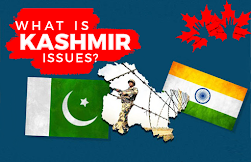Introduction
Kashmir is an ethnically diverse Himalayan region, covering around 86,000 sq miles (138 sq km), and famed for the beauty of its lakes, meadows and snow-capped mountains.Even before India and Pakistan won their independence from Britain in August 1947, the area was hotly contested.Under the partition plan provided by the Indian Independence Act, Kashmir was free to accede to either India or Pakistan.The maharaja (local ruler), Hari Singh, initially wanted Kashmir to become independent - but in October 1947 chose to join India, in return for its help against an invasion of tribesmen from Pakistan.
Pre-History of Kashmir Conflict
The British Indian Empire was formed of hundreds of princely states spread all over the Indian Subcontinent. After the World War II, when the British finally decided to bring their rule to an end, the fate of these princely states was brought under scrutiny. The Princely states were now supposed to join either India or Pakistan after the British authorities leave.Finally in June, 1947, the British accepted Pakistan Plan. But the Hindu Maharajah Sir Hari Singh (the ruling monarch of the erstwhile princely state of Kashmir) was hesitating to join either Pakistan or India. However, the census of 1941 shows that almost 77% of the population of Kashmir was comprised of Muslims (Das 264). Since the Maharajah had acceded to neither side until the formation of India and Pakistan in August, 1947, Pakistan decided to act along communal lines. Being a Muslim dominated state, it decided to ‘liberate’ Kashmir and backed the Azad Kashmir Force. In October, 1947, Pakistan invaded Kashmir and captured its northern and western parts. On the Maharajahs request and accession to India, the authorities in Delhi now reacted by sending troops to the region and Pakistani advances were arrested soon. Thus, the southern and eastern parts of the region were retained in the Indian Union and constituted as the state of Jammu and Kashmir.
Causes of the Conflict
To understand the causes of the conflict, the historic Partition of India has to be referenced. Under the British Rule, Indian Subcontinent was mainly inhabited by the two major religious groups, Hindus and Muslims. The two communities had friendly relationships and they offered a united struggle to achieve independence from the British Rule during the later half of the Nineteenth Century. But undercurrents of tension between the two communities became forceful with the lapse of time. Power politics between All India Muslim League and Indian National Congress (the two major political powers of the undivided India) culminated at widespread communal tension and violence during the 1930s and early 1940s. Consequently, the colossal task of partitioning India became unavoidable. After the Partition in 1947, Pakistan emerged as a Muslim dominated state while India emerged as a secular, democratic country. And the province of Kashmir, which is situated at the border of the two countries, got tangled and entrapped between them.
Further Readings...
Download


Post a Comment